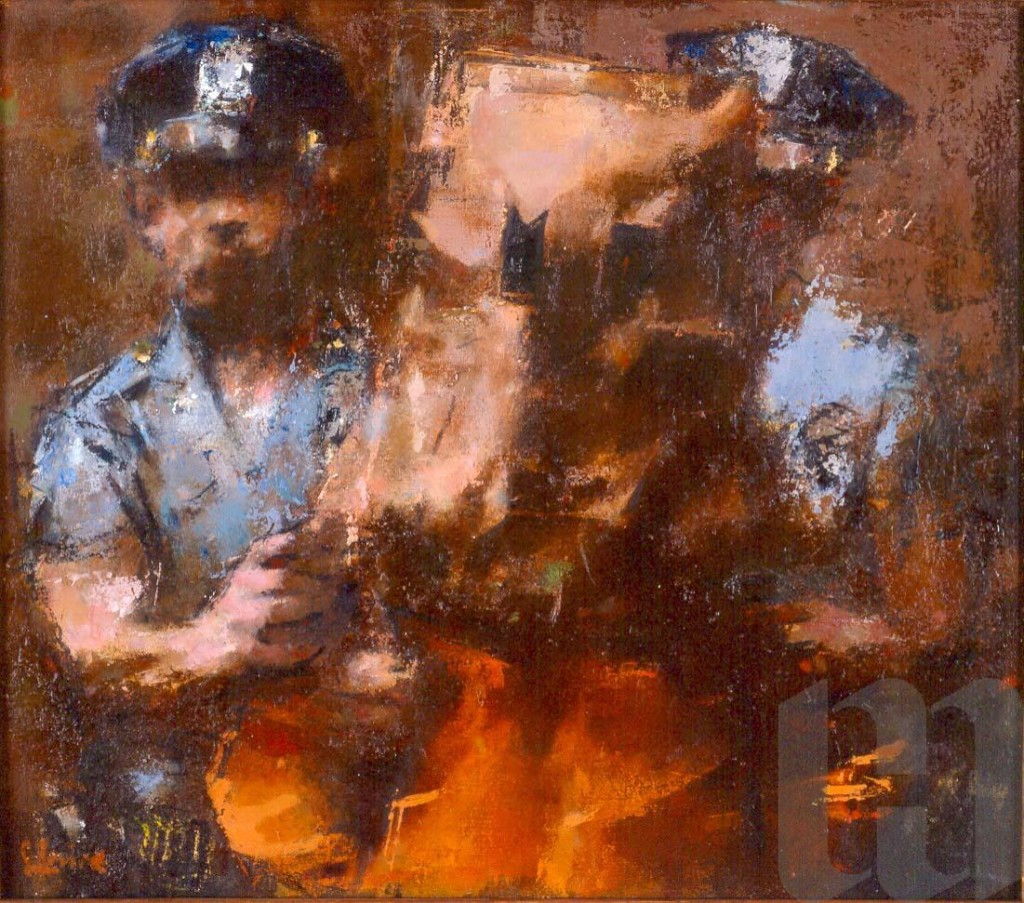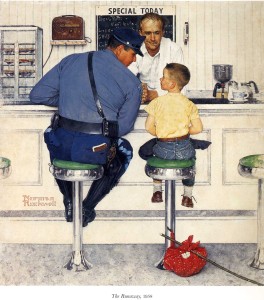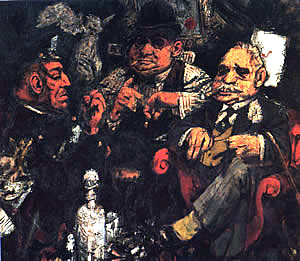We are living in a time of increasing friction between law enforcement agencies and the citizens they serve. Violent confrontations between the police and members of minority communities have been recorded by bystanders. The resulting videos have quickly captured a national audience, causing the formation of groups such as ‘Black Lives Matter’ and leading to civil unrest. Though it was painted 32 years ago, Jack Levine’s painting “The Arrest” is more topical than ever.
Levine, who died in 2010 at the age of 95, has been described as a Social Realist, and his paintings, often crowded with satirically characterized figures, display his questioning of traditional authority and his uneasy relationship with contemporary culture. Openly hostile to the abstract styles of art dominant in the second half of the 20th century, Levine hearkened back to satirists such as Honoré Daumier and William Hogarth. “The Arrest”, while somewhat comical and obvious in its subject matter, is actually a tangle of questions about the nature and use of authority—questions that have been evolving with increasing urgency in the years after WWII.
This dramatic painting contains three figures. On the left is an almost featureless white policeman whose powerful grip on the arrested person is both prominent and dominant in its determined act of control. Indeed, it is this figure’s muscular right arm, not his facial expression, that defines him. On the right a more shadowy policeman emerges from the background. He might or might not be African-American, and, though still an agent of the state, he exercises control in a less obvious way. Finally, and most prominently placed, is the faceless, genderless, raceless prisoner—a mysterious “everyperson” caught up in the net of social authority. This prisoner takes up almost half of the picture area and is thrust forward in the picture plane enhancing his or her visual prominence, but despite the compelling placement in the composition, this is a person controlled by powers that literally have grip on him or her. A difficult and emotional moment for anyone, but a bag with bizarrely shaped eye holes conceals the face. It is this bag, this mask covering the reality of feeling, that gives the prisoner a look of wry bemusement, as if saying, “of course this is happening to me, what did you expect?” It is a moment Franz Kafka would understand.
However in mid-century America, not too long before Levine painted “The Arrest”, such questions about civic authority were restricted to left wing journals and “radical” publications. In 1958 Norman Rockwell painted a magazine illustration called “The Runaway”. It is far removed in its sentiments from “The Arrest”. In Rockwell’s image, the powers of society are responsible and understanding. Likely the man running the diner called his friend the policeman upon seeing the young runaway. The policeman, for his part, is using gentle persuasion to guide the boy into choosing to return home. And finally, the boy clearly accepts and respects the authority of the adults around him. The body language of all the participants is benign and caring. It’s a beautiful world in its innocence and social connectedness. No doubt it was also one that rarely existed outside the longings of the Saturday Evening Post readers, but one that Americans, at least most middle and upper class white Americans, chose to believe. (For a recent satirical view of Rockwell’s iconic image see: Mad Magazine.)
If Levine’s painting presents a different world, perhaps it is because much happened between 1958 and 1983. The Vietnam War alienated many of America’s youth. The “police riot” at the 1968 Democratic Convention in Chicago was televised to a shocked nation as viewers watched Mayor Richard Daley’s political machine use its power to crush political protest. “Don’t trust anyone over 30” became a common refrain even before the Watergate hearings showed that criminal and self-serving behavior ran all the way to the White House. In many quarters public authority became looked upon as mere social control at the beck and call of a political and financial elite that had little interest in administering evenhanded justice.
The country may have been surprised by the events of the 1960’s and 70’s, but they led us as a nation to a perspective on authority that Jack Levine had long held. Certainly his distrust manifested itself early enough. A half century before, in 1937, he painted “The Feast of Pure Reason”, which depicts a policeman, small businessman, and rich capitalist meeting to use their resources to their advantage. Their faces are well fed and complacent. Their selfish empowerment is banal and self-satisfied. Levine, who was born poor and whose first studio was in a slum neighborhood in Boston, had little reason to think that the game wasn’t rigged. In his world the rich and powerful have the law, the police, and the courts to enforce their will.
“The Feast of Pure Reason” tells us much about how we might view “The Arrest.” The police depicted in the painting use force (though by today’s standards it is quite restrained), but they are also rather neutral and detached in the process of doing so. They offer no sympathy and show no outrage. Who are these men? What do they think? What is their stake in this moment? It appears that they are merely agents of control, pure and simple. The three figures–the prisoner in the foreground, the policeman on the left, and the policeman on the right–each recedes further into the background, suggesting that somewhere in the darkness behind them, someone else is in control. Someone for whom this moment is a desired outcome. Someone not unlike the men in “The Feast of Pure Reason”.
But what of the anonymous prisoner? Has this person committed a heinous crime? Could he or she be a violent criminal that society must lock up for its protection? Or someone much less dangerous, a petty thief perhaps? Or a political prisoner? Is the crime merely being who or what he or she is? We don’t know and the policemen don’t seem to care. They do what they do for the people who tell them to do it. This lack of feeling extends to the behavior of the prisoner. Regardless of the force in the policeman’s grip, the body language of the prisoner is completely neutral, too. There is no struggle. And because the bag masks any facial expression, we don’t see anger or resignation or, for that matter, any emotion. Indeed, the covered face suggests the mask we all wear when facing compelling and controlling authority. To reveal true feelings at such a moment would be to give away the little dignity you still possess.
In Jack Levine’s “The Arrest”, there is force and there is submission. That is all. Right and wrong are not present.
This essay is part of the Thinking About Paintings series.
Click the link to return to the listing of other articles


